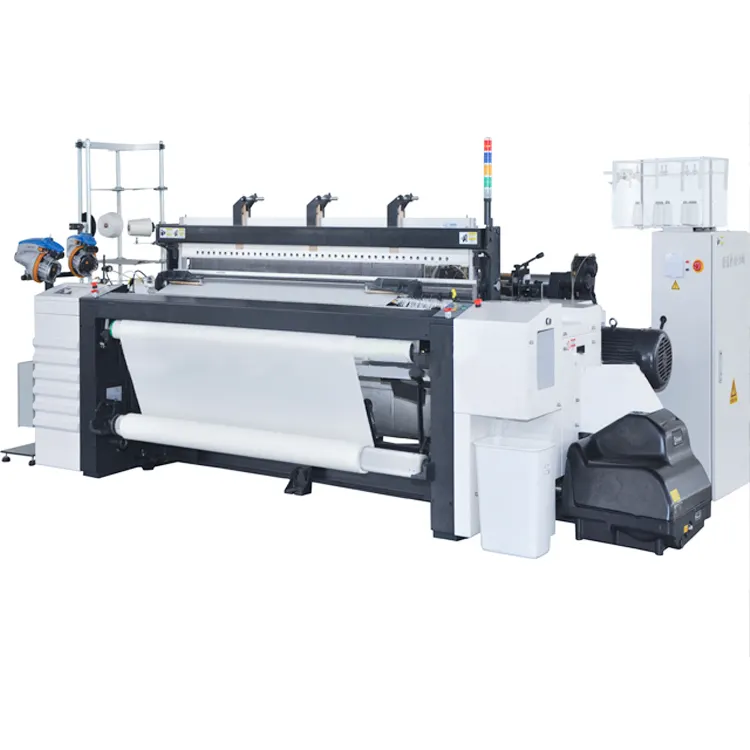The function of the cloth rolling mechanism is to draw the already woven fabric away from the fabric fell in time and quantitatively according to the requirements of the weft density of the fabric, and roll it onto the take-up roller, so that the position of the fabric fall will not change due to the introduction of new weft yarns, thus ensuring Weaving production can be carried out continuously.
1. Classification and process requirements of coiling mechanism
1. Classification According to the nature of the exercise, it can be divided into two categories: intermittent and continuous.
According to the nature of the transmission, it can be divided into two categories: mechanical and electronic.
The mechanical intermittent coiling mechanism is not used by high-speed looms because its intermittent action will cause greater impact and wear between the transmission parts. On the high-speed shuttleless loom, the mechanical continuous coiling mechanism is widely used, and now more and more air-jet looms use the electronic continuous coiling mechanism.
2. Process requirements for coiling
(1) The take-up mechanism should ensure that the formed fabric is drawn away from the weaving mouth on time and at a fixed length to obtain a fabric with a specified weft density, and at the same time draw the warp yarn released from the weaving shaft by the let-off mechanism to the fabric forming area.
(2) The transmission movement should be accurate and stable to ensure uniform weft density, the weft density adjustment is quick and easy, and the adjustment range should meet the process requirements.
(3) The cloth rolling roller should be light and easy to carry, and the roll should be large to reduce the number of times of cloth falling; the tension of the cloth rolling should be uniform, the cloth surface should not have wrinkles, and the loading and unloading of the cloth rolling roller should be convenient.
(4) Manual operation should be simple and labor-saving.
The coiling mechanism is generally composed of several parts such as coiling drive, weft density adjustment, holding traction, winding forming, manual operation, and automatic length counting.
Transmission path yarn supply side crankshaft—synchronous toothed belt—reduction gear box—weft density conversion and reduction gear train—coiler and coiler pressure roller—sprocket on the coiler—chain—flywheel—plane friction clutch—friction Shaft—cloth roll.
Winding forming mechanism: After the woven fabric is pulled away from the cloth mouth under the action of the gripping and pulling mechanism, it is regularly wound on the cloth winding roller under the action of the winding forming mechanism according to a certain tension. The winding forming mechanism is composed of sprocket, flywheel, chain, friction clutch, cloth winding roller and cloth roller clamping seat, etc. The diameter of the rolled cloth is 100-600mm. During the cloth rolling process, the diameter of the cloth roll increases gradually, and the resistance torque to the cloth roll will also increase under the same cloth surface tension condition, which requires the driving torque to increase with the increase of the cloth roll diameter, so that Ensure that the driving torque can effectively drive the cloth roll to work. When the diameter of the cloth roll increases, the detection plate of the cloth roll in the mechanism is pushed to the rear of the machine, which increases the positive pressure of the friction clutch, so that the driving torque of the cloth roll increases with the increase of the diameter of the cloth roll. When the driving torque is greater than the resistance torque, the cloth roller rotates synchronously with the flywheel; on the contrary, the clutch slips, and the speed of the cloth roller is slower than that of the flywheel, so as to ensure the process requirement that the cloth tension is basically constant.
Manual operation mechanism: it is used for manual winding or inversion of the winding mechanism when the warp is drawn or when the fabric has weaving defects, and the structure is simple.
Length counting device: Mechanical decade counter with automatic stop function at fixed length. Automatically calculate the fabric length according to the weft density of the fabric and the beating times of the loom.
Electronic take-up mechanism
The electronic take-up mechanism can be combined with the let-off mechanism to adjust the loom position under the control of the microprocessor to improve the fabric quality.
Advantages of electronic coiling mechanism:
(1) The fabric weft density only needs to be set directly on the computer or the keyboard of the control device, and there is no need to replace the weft density gear. The range of weft density is large, which enhances the variety adaptability of the fabric.
(2) During the weaving process, the weft density can be automatically changed as required. This is the most obvious and important feature of the electronic take-up mechanism. This feature enables the loom to produce fabrics with variable weft density.
Organization Profile:
(1) The transmission path of the take-up roller: the rotation of the take-up motor, the motor pulley, the toothed belt and the toothed pulley, the worm in the take-up gearbox, the worm gear compound gear, the compound shaft, the take-up roller gear, the take-up roller take-up roller Rotating at a certain speed ensures a certain weft density.
(2) The path of the cloth is the same as that of the mechanical winding.
(3) The driving of the cloth rolling roller is the same as that of the mechanical winding: the sprocket on the winding shaft rotates the roller chain flywheel and the driving of the winding tension device gear cloth roller.
Post time: Apr-24-2023





